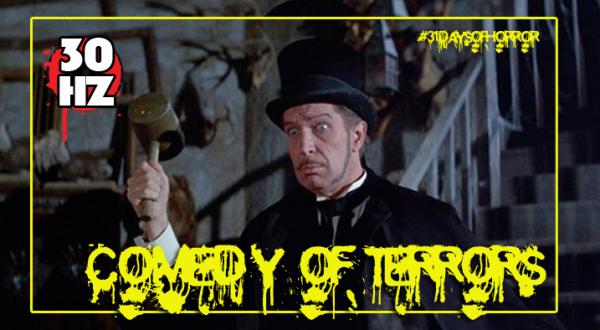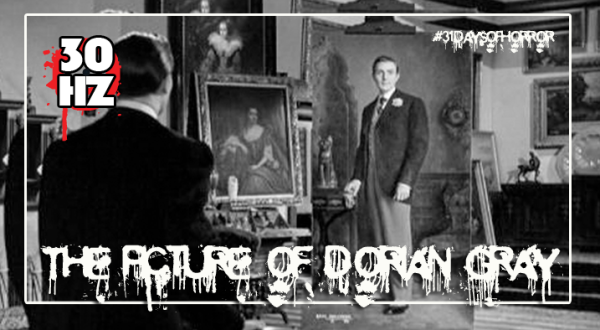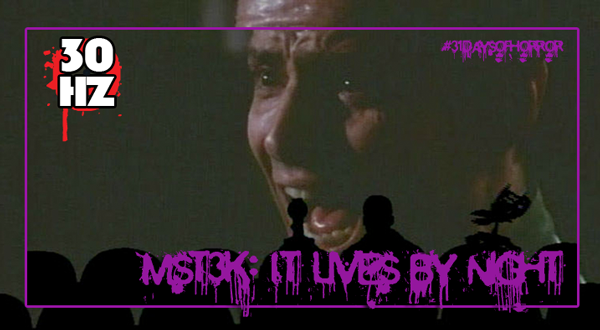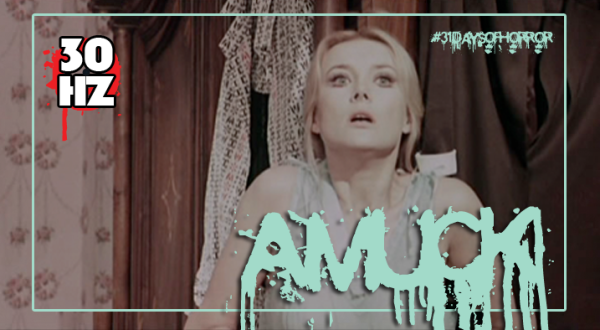Last year I called out to the masses, urging them to join me on a cleansing 31-Day Horror Shame-a-thon. As many horror movies as you can watch in one month — the catch? They all had to be shamers, movies you regret not having seen at this point in your moviewatching career. I had one taker. (Thanks, Kerry!) Well, this year, I’m done with with the safety-in-numbers thing. This time, see, I’m going it alone (alone except for everyone else out there doing their own lists… like Jaime Burchardt, who does this for super serious). All the horror and rigors of a brutal moviewatching regimen without a specific support group, plus, you know… life and stuff that just happens in between horror movies. And when you’ve got a 3yo and a 6yo that “life and stuff” part puts a major damper on the final total.
I’ll again follow the Cinema Shame method. I’ll create a list of 31 never-before-seen horror flicks (broadly defined as anything horror or containing elements associated with horror movies) and watch as many as I can manage over the course of the October month. I won’t watch all of them. After all, this list is a tentative guide, some self-cajoling. I watch some, go off the rails for others, and watch a few impromptu selections on TCM. I’ll attempt to view at least one from every decade 1920’s through the present. Last year, I viewed 27 — my all time documented* high. (*I’m sure I obliterated that total during my high school days. Comparing moviewatching prolificity at 37 years of age (with two kids and a wife that doesn’t watch horror movies) vs. 16 years of age (with, maybe, some homework in Photography class and a daily golf practice schedule) is like comparing the kid on your Little League team that handcuffed himself to the dugout fence to Mickey Mantle.
After each flick, I’ll toss up a mini review that may or may not contain any actual insight alongside a Hz Record rating. All that said, let’s commence the 31 Days of Horror.
First up. The list of Shame. For this list, in addition to egregious and overdue Shames (hello again, Texas Chainsaw Massacre and The Wicker Man!), I’ll focus on the movies I’ve owned but never watched (blind buys, specifically, but also those that have just been forgotten over time).
Other #31DaysOfHorror participants!
@echidnabot – Prowler Needs a Jump
Past #31DaysOfHorror Shame-a-thons: 2013 | 2014 | 2015 Part 1 | 2015 Part 2
- Cat and the Canary (1927)
Island of Lost Souls (1932)The Picture of Dorian Gray (1945)- La Momia Azteca (1957)
- Scream of Fear! (1961)
- The Innocents (1961)
- Burn Witch Burn (1962)
- Kwaidan (1964)
Nightmare Castle (1965)- The Living Corpse (Pakistani Dracula! – 1967)
The Living Skeleton (or another from When Horror Came to Shichoku Eclipse Set, 1968)- Koroneku (1968)
- Vampyros Lesbos (1971)
Amuck! (1972)- Night of the Devils (1972)
- A Candle for the Devil (1973)
- The Wicker Man (1973)
Sugar Hill (1974)- Texas Chainsaw Massacre (1974, on 2014 and 2015 Shame lists)
Alucarda (1977)- Nosferatu (1979)
- Without Warning (1980)
- Scanners (1981)
- The Boogens (1981)
- The Strange Case of Dr. Jekyll and Miss Osbourne (1981)
Fright Night (1985)- Nightmare on Elm Street 2 (1985)
- Killer Party (1986)
- Inugami (2001)
- Romasanta (2004)
- A Girl Walks Home At Night (2014)
Off the menu:
FrogsBeyond the Black RainbowComedy of TerrorMST3K – It Lives By NightThe Beast With Five FingersCorruption
(Hz ratings out of 5 Hz)
#1. 9/30 – Frogs (1972, dir. George McCowan)
There’s a brilliant simplicity about movies like Frogs or Alligator or Piranha. You’re offered people that deserve to be eaten by Frogs/Alligators/Piranhas and then, wait for it, they get eaten by Frogs/Alligators/Piranhas. There’s nothing especially unnerving about Frogs (except Sam Elliott disarmingly sans mustache) – it’s just a fun nature-gone-evil flick with a lot of closeups of — get this — frogs! Also, a horror movie fest isn’t a horror movie fest without Ray Milland (I’m sure that’s a saying) so I’m glad I got that requirement out of the way early. Also yes, I started early because I need all the days I can pack into one month to make this happen.
#2. 9/30 – Beyond the Black Rainbow (2010, dir. Panos Cosmatos)
Watched this for our #Bond_age_Choice feature the other night without knowing what I’d signed up for. Hey, so, good to know… this is what happens when Carl Theodor Dreyer sodomizes David Cronenberg. Though this isn’t outright horror this one will leave you unsettled for days. Truth be told, I have not yet recovered from the scene pictured above. I’ve still got the heebeejeebees. Cosmatos scrubbed this movie free of dialogue. Abstract imagery and use of washed-out color palettes foster an unsettling, creeping subtext that ultimately manifests as a riff on the slasher or giallo genres.
Greg McCambley summed this movie up best:
Man, this movie is going to be sitting on my brain like a vulture on a tree branch waiting for something to die. #Bond_age_
— Canucklehead (@GregMcCambley) October 1, 2015
#3. 10/2 – Alucarda (1977, dir. Juan Lopez Moctezuma) 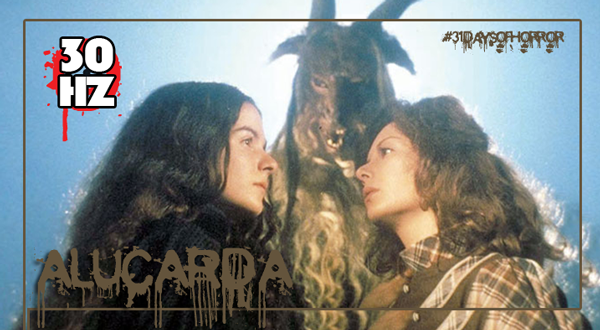
Justine arrives at a creepy convent where she immediately befriends the even creepier Alucarda who tells her, almost immediately, that she’s going to “love her to death.” And based on her delivery you’re quite sure there’s no Shakespearean orgasm metaphor mixed into that statement. After a quick flash of light and a jump cut, both girls are buck naked and flanking Mr. Scary Goat Man. Before you know it that crazy Alucarda has unleashed some satanic demon that dabbles in vampirism. There’s even an interesting footnote to the nudity and satanic rituals that suggests satanism was the natural counter-reaction to the innate brutality of the Catholic church. How strict enforcement of the Catholic doctrines (by the clerical male hierarchy) transforms innocent girls into fearful women rather than encouraging proper religious hope and spirituality.
#4. 10/3 – Island of Lost Souls (1932, dir. Erle C. Kenton)
After enduring the wife’s pick of Hot Pursuit on Friday night, I got back on the wagon Saturday night. Though she won’t willingly watch anything from the horror genre, she will get sucked into an older movie if it happens to show up on the television and she’s already on the couch and the effort to go upstairs to watch something on the DVR proves too daunting. I figured I could win her over with this little ditty. And by “ditty” I mean subtle and often unnerving slice of pre-code horror that happens to last something shy of 80 minutes. Having just watched the Lost Souls documentary about the making of the Brando/Kilmer 1990’s Moreau I was itching to finally give this Criterion a spin. Really the best thing that could be said about our leading man, Richard Arlen, is that he had fine posture. Charles Laughton binds this movie together with a tense portrayal of Moreau as a misguided, moralistic Dr. Frankenstein-type God complex. Despite recognizing the film’s duly earned status as a classic, I couldn’t help but rattle of a few lines of “Jump Around” every time a character mentioned the “House of Pain” or respond to “We are men!” with “We are DEVO!” I’m so mature. Terrific minor turns from Bela Lugosi and “the Panther Woman” (as she is billed in the credits), Kathleen Burke, help erase the harm caused by milquetoast leading man syndrome.
#5. 10/3 – Comedy of Terrors (1963, dir. Jacques Tourneur)
…words coming soon…
#6. 10/4 – The Picture of Dorian Gray (1945, dir. Albert Lewin)
It took me a few days to process this adaptation of Oscar Wilde’s The Picture of Dorian Gray. I felt like the film required a bit more attention perhaps than an MST3K riff on The Bat People. First, let’s get some scattered observations out of the way. 1. Every movie should feature George Sanders. Also dialogue by Oscar Wilde in the mouth of George Sanders. 2. There’s a reason Hurd Hatfield had a minimal and very scattered Hollywood career. After a handful of starring gigs, Hatfield drifted off into a career in television. He’s suitable here (if my memory of the novel serves) because he satisfies Oscar Wilde’s Dorian Gray, but he’s unable to carry the film on his own — a very strong supporting cast props him up (meanwhile acting circles around him). Angela Lansbury, George Sanders, Donna Reed and Peter Lawford among them. 3. Harry Stradling, Sr. was a goddamn genius. The man worked for Hitchcock, Ray, Kazan, Mankiewicz, etc. Clearly, he knew what he was doing. This 1945 adaptation of Dorian Gray succeeds admirably in translating the gothic elements of Wilde’s novel to the screen and creating constant tension beneath the placid exterior events. As Dorian slips further into vanity and depravity (his specific actions barely even mentioned), director Albert Lewin manages the tone of the film accordingly. While the actual disfigurement of the portrait is presented in ghastly neon coloration and far less affecting than the novel’s ability to terrorize the mind’s eye, the film’s brilliant cinematography makes up the difference. The fear and tension are derived naturally from the terrors of time, fate and mortality. Dorian Gray’s plight is the human condition, not the supernatural, menacing portrait or Dorian’s vanity. There is in fact no villain present; there is only our own fears and regrets conveyed through Dorian and the visual majesty of light and shadow.
#7. 10/5 – MST3K: It Lives By Night (aka The Bat People, 1974, Jerry Jameson)
“GAH! The bats are causing me to not know how to stop a car!” I’ve made it a practice to watch at least one MST3K horror movie riff each 31 Days of Horror. If it wasn’t a documented practice before, it is now. Scanning the 30+ sets along the shelf, I recognized I’d never seen this experiment. Bob’s your uncle. Dude gets bitten by a bat then becomes a bloodsucking bat. The riffs here from Mike and the bots weren’t hugely memorable, always a problem when the movie at hand is more boring-bad than bad-bad. The good jokes happened while anthropomorphizing bats during stock footage, comparing the leading actress to Mary Tyler Moore and mocking the letchy, mustachioed detective. A well-placed Rikki-tikki-tavi joke may have been the golden riff.
#8. 10/6 – Amuck (1972, dir. Silvio Amadio)
Holy. Smokes. Seven minutes into Amuck, the viewer’s treated to a slow-mo, wholly gratuitous scene of sapphic excess between Barbara Bouchet and Rosalba Neri. I don’t care if you’re man, woman, child (not that I’m testing this theory, mind you), plant or animal, you’d be impressed. Perhaps for different reasons. Perhaps for all the reasons. Visceral, theoretical, whatever your pleasure. The overt purpose and confidence by Amadio to render the scene in slow motion (and so early in the film) took me by surprise. I don’t know why, exactly, considering that the giallo genre has two general statements of purpose: #1. Suspense #2. Cast amazingly, legendarily beautiful women and worship them appropriately. …and Amuck duly satisfies on both counts. That the film is not more widely known and that Amadio failed to forge a decent career in the genre puzzles me. Released on a mismatched “Spaghetti Cinema” double-feature from Code Red (with Super Stooges & the Wonder Women), the print used on the DVD has not been restored and occasionally becomes jumpy and/or speckled and/or faded. More love and restoration has been given to gialli half as good as Amuck. Someone, anyone, take Amuck and make it whole again.
#9. 10/9 – Sugar Hill (1974, dir. Paul Maslansky)
 Low-budget blaxploitation voodoo zombie flick. Marki Bey’s an on-screen force, rocking the deep-v jumpsuit, dishing one-liners and unleashing hordes of zombies in the name of cold, calculated revenge. B-grade Baron Samedi doesn’t really dampen the proceedings, though I couldn’t help but imagine how much better the movie would have been with Geoffrey Holder (who, of course, played Baron Samedi in Live and Let Die). One tweet probably summarized my experience with Sugar Hill:
Low-budget blaxploitation voodoo zombie flick. Marki Bey’s an on-screen force, rocking the deep-v jumpsuit, dishing one-liners and unleashing hordes of zombies in the name of cold, calculated revenge. B-grade Baron Samedi doesn’t really dampen the proceedings, though I couldn’t help but imagine how much better the movie would have been with Geoffrey Holder (who, of course, played Baron Samedi in Live and Let Die). One tweet probably summarized my experience with Sugar Hill:
Chicken foot on a string wins top prize for best special effect in #SugarHill. #31DaysOfHorror — The #Bond_age_ Ghoul (@007hertzrumble) October 9, 2015
#10. 10/11 – The Beast With Five Fingers (1946, dir. Robert Florey)
DVR’d this on Turner Classic Movies even though I’d already seen it a couple years ago… on TCM. Here’s the catch. I’d swapped this one in my brain with Mad Love, another film starring Peter Lorre that has to do with murderous hands gone wild. The difference between the two is that in Mad Love the murderous (knife throwing!) hands are still attached to someone whereas in The Beast With Five Fingers the murderous, detached hand goes rogue. Two minutes into the film I’d recognized my faulty memory. Happy accident, I suppose. The Beast is great entertainment because this movie about a (permit the repetition here, for effect) murderous, detached hand of a dead concert pianist is played completely straight. Peter Lorre gets to play a man haunted by said murderous, detached hand and make all sorts of fantastic faces while being stalked by the hand. If you haven’t stopped reading this to go watch The Beast With Five Fingers, you must have already seen it. In which case, you already know the joy of movies featuring a murderous, detached hand that also moonlights on the piano during the middle of the night. Maybe it’s not a 4-star flick, but it’s definitely worth 4 Hz in my book. Watch with friends. Take turns making Peter Lorre faces.
#11. 10/12 – Corruption (1968, dir. Robert Hartford-Davis)
Corruption owes its continued notoriety to being partly an indictment of the 1960’s fashion scene. There’s mod fashions and swinging parties and Peter Cushing robbing the cradle… and it is these era-specific eccentricities that elevate Corruption above your standard mad scientist frivolity.
Vanity. Superficiality. Youth. These two themes provide the backbone. Peter Cushing supplies the crazy eyes and reluctant homicides. His wife (Sue Lloyd) goes full Lady Macbeth after a photography flood lamp topples on her (oops), badly burning her face. Cushing’s surgeon has found a way to rehabilitate scarred tissue, except he needs fresh adrenal glands, don’t you know, to keep the skin from turning back into pizza. The wife drives his madness, but Cushing’s obsession with the looks of his young wife underlies something beyond his wife’s vanity. Cushing’s doctor (at least 30 years her senior) becomes obsessed with preserving her visage. As if having the beautiful, young model/wife also proves his own virility in this fast-paced glamorous world that has since passed this stodgy old curmudgeon by.
Together the pair become horrible monsters, inside and out. Not an especially *fun* flick — but one that resonates due to the embedded social commentary.
#12. 10/13 – The Living Skeleton (1968, dir. Hiroshi Matsuno)
The star of The Living Skeleton (one of the four features in the When Horror Came to Shochiku Criterion set) has to be the overcooked photography. High contrast with moody, soft focus. It’s a whole heap of atmosphere coupled with absolutely hilarious cheapy effects. Bats on wires. Superimposed bat shadows. Floating underwater skeletons that look like knockoff Day of the Dead tchotchkes from a roadside attraction in Indiana. Miniature boats plucked from cereal boxes. Skeleton is part ghost story, part crime thriller and part mad scientist movie. It’s everything you could possibly need… or it’s a bit much all at once. Probably depends on your mood. Still, it’s pretty clear that John Carpenter likely saw this before prepping The Fog. And despite the comical effects that occasionally pull you out of the film’s spell, The Living Skeleton resonates because of the cinematography and the performance of Kikko Matsuoka. Or maybe it’s just her eyes. Either way, this one’s a keeper. If only George Lucas could go back and maybe touch up those skeletons a bit for a Special Edition release.
#13. 10/14 – Nightmare Castle (1965, dir. Mario Caiano, Jack Hill)
I’ve been plagued by enjoyment without hyperbolic enthusiasm this October. A lot of the movies I’d built up in my head as the next great addition to my movie-watching resume have been good or very good, but just haven’t sent me over the moon. (On the flipside I haven’t really seen any stinkers to inspire a good honest rampage.) And you’re reading this and you’re thinking that clearly Nightmare Castle finally granted me this OMFG, YEAH! moment. But alas. It’s just the movie that hammered home this notion. I had Barbara Steele expectations, you see. Many of Steele’s flicks have warmed my cockles in the past. (Black Sunday! Castle of Blood!) I’d owned a bargain basement version of the Nightmare Castle DVD for at least a decade without ever fully watching it. I popped it in once, but the experience was like watching a film through Vaseline. So there it sat… until Severin Films stepped up with this exquisite Blu-ray edition. I tossed the original DVD in the donation pile and happily purchased a replacement.
Like most of Steele’s films, Nightmare Castle falls squarely into the gothic category of horror films. Think Roger Corman’s Edgar Allan Poe adaptations. The tone feels more like a British production than an Italian and could easily be considered a precursor to the kind of mad doctor situation that plays out a couple years later in Corruption. The doctor sets a trap for his wife and her lover. After catching them in the coital act, he tortures and eventually kills them. He then marries the dead wife’s sister to finagle the inheritance and, wouldn’t you know it, the deceased come back to haunt the castle. Or are they just visions in the sister’s corrupted brain? It’s a solid premise that never fully pays off because the viewer probably never finds the outcome in doubt. The ending reminded a bit too much of Elvira and Tor Johnson stomping around the foggy swamp in Plan 9 from Outer Space.
So Nightmare wasn’t the overlooked masterpiece for which I’d hoped. The transfer looks amazing, and the special features (full presentations of Castle of Blood and Terror Creatures from Beyond the Grave included) make this an essential purchase for fans of the genre.





